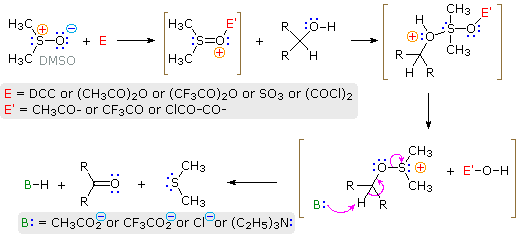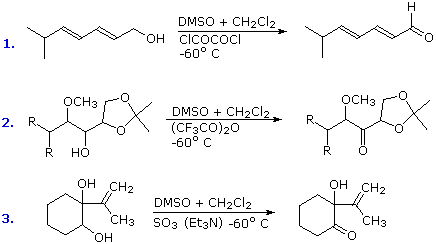


 علم الكيمياء
علم الكيمياء 
 الكيمياء التحليلية
الكيمياء التحليلية 
 الكيمياء الحياتية
الكيمياء الحياتية 
 الكيمياء العضوية
الكيمياء العضوية 
 الكيمياء الفيزيائية
الكيمياء الفيزيائية
 الكيمياء اللاعضوية
الكيمياء اللاعضوية 
 مواضيع اخرى في الكيمياء
مواضيع اخرى في الكيمياء
 الكيمياء الصناعية
الكيمياء الصناعية |
Read More
Date: 1-8-2019
Date: 21-10-2020
Date: 1-12-2019
|
The conversion of 1º and 2º-alcohols to aldehydes and ketones is an important reaction which, in its simplest form, can be considered a dehydrogenation (loss of H2). By providing an oxygen source to fix the product hydrogen as water, the endothermic dehydrogenation process may be converted to a more favorable exothermic one. One source of oxygen that has proven effective for the oxidation of alcohols is the simple sulfoxide solvent, DMSO. The reaction is operationally easy: a DMSO solution of the alcohol is treated with one of several electrophilic dehydrating reagents (E). The alcohol is oxidized; DMSO is reduced to dimethyl sulfide; and water is taken up by the electrophile. Due to the exothermic nature of the reaction, it is usually run at -50 ºC or lower. Co-solvents such as methylene chloride or THF are needed, since pure DMSO freezes at 18º. The reaction of oxalyl chloride with DMSO may generate chlorodimethylsulfonium chloride which then oxidizes the alcohol (Swern Oxidation). Alternatively, a plausible general mechanism for this interesting and useful reaction is drawn below.

Because so many different electrophiles have been used to effect this oxidation, it is difficult to present a single general mechanism. Most of the electrophiles are good acylating reagents, so it is reasonable to expect an initial acylation of the sulfoxide oxygen. (The use of DCC as an acylation reagent was described elsewhere.) The electrophilic character of the sulfur atom is enhanced by acylation. Bonding of sulfur to the alcohol oxygen atom then follows. The remaining steps are eliminations, similar in nature to those proposed for other alcohol oxidations. In some cases triethyl amine is added to provide an additional base. Three examples of these DMSO oxidations are given in the following diagram. Note that this oxidation procedure is very mild and tolerates a variety of other functional groups, including those having oxidizable nitrogen and sulfur atoms.




|
|
|
|
تفوقت في الاختبار على الجميع.. فاكهة "خارقة" في عالم التغذية
|
|
|
|
|
|
|
أمين عام أوبك: النفط الخام والغاز الطبيعي "هبة من الله"
|
|
|
|
|
|
|
بمساحة تزيد على (4) آلاف م²... قسم المشاريع الهندسية والفنية في العتبة الحسينية يواصل العمل في مشروع مستشفى العراق الدولي للمحاكاة
|
|
|